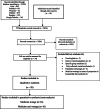Medicine storage, wastage, and associated determinants among urban households: a systematic review and meta-analysis of household surveys
- PMID: 34118923
- PMCID: PMC8196539
- DOI: 10.1186/s12889-021-11100-4
Medicine storage, wastage, and associated determinants among urban households: a systematic review and meta-analysis of household surveys
Abstract
Background: Irrational household storage of medicines is a world-wide problem, which triggers medicine wastage as well as its associated harms. This study aimed to include all available evidences from literature to perform a focused examination of the prevalence and factors associated with medicine storage and wastage among urban households. This systematic review and meta-analysis mapped the existing literature on the burden, outcomes, and affective socio-economic factors of medicine storage among urban households. In addition, this study estimated pooled effect sizes for storage and wastage rates.
Methods: Household surveys evaluating modality, size, costs, and affective factors of medicines storage at home were searched in PubMed, EMBASE, OVID, SCOPUS, ProQuest, and Google scholar databases in 2019. Random effect meta-analysis and subgroup analysis were used to pool effect sizes for medicine storage and wastage prevalence among different geographical regions.
Results: From the 2604 initial records, 20 studies were selected for systematic review and 16 articles were selected for meta-analysis. An overall pooled-prevalence of medicine storage and real wastage rate was 77 and 15%, respectively. In this regard, some significant differences were observed between geographical regions. Southwest Asia region had the highest storage and wastage rates. The most common classes of medicines found in households belonged to the Infective agents for systemic (17.4%) and the Nervous system (16.4%). Moreover, income, education, age, the presence of chronic illness, female gender, and insurance coverage were found to be associated with higher home storage. The most commonly used method of disposal was throwing them in the garbage.
Conclusions: Factors beyond medical needs were also found to be associated with medicine storage, which urges effective strategies in the supply and demand side of the medicine consumption chain. The first necessary step to mitigate home storage is establishing an adequate legislation and strict enforcement of regulations on dispensing, prescription, and marketing of medicines. Patient's pressure on excessive prescription, irrational storage, and use of medicines deserve efficient community-centered programs, in order to increase awareness on these issues. So, hazardous consequences of inappropriate disposal should be mitigated by different take back programs, particularly in low and middle income countries.
Keywords: Expired; Home storage; Household; Medicine; Not in use; Wastage.
Conflict of interest statement
The authors declare that they have no competing interests.
Figures







Similar articles
-
A survey on the extent of medication storage and wastage in urban Iranian households.Clin Ther. 2005 Jun;27(6):970-8. doi: 10.1016/s0149-2918(05)00122-0. Clin Ther. 2005. PMID: 16117997
-
Storage practice and wastage of pharmaceuticals in Chinese urban-dwelling households: Description of urban-dwelling households.Public Health Nurs. 2025 Jan-Feb;42(1):179-191. doi: 10.1111/phn.13401. Epub 2024 Sep 29. Public Health Nurs. 2025. PMID: 39344285
-
An economic assessment of the extent of medication use and wastage among families in Saudi Arabia and Arabian Gulf countries.Clin Ther. 2003 Apr;25(4):1276-92. doi: 10.1016/s0149-2918(03)80083-8. Clin Ther. 2003. PMID: 12809973
-
Prevalence and Estimated Economic Burden of Substandard and Falsified Medicines in Low- and Middle-Income Countries: A Systematic Review and Meta-analysis.JAMA Netw Open. 2018 Aug 3;1(4):e181662. doi: 10.1001/jamanetworkopen.2018.1662. JAMA Netw Open. 2018. PMID: 30646106 Free PMC article.
-
Storage and disposal of pharmaceuticals at home: a systematic review.Cien Saude Colet. 2020 Feb;25(2):585-594. doi: 10.1590/1413-81232020252.10882018. Epub 2018 Jun 20. Cien Saude Colet. 2020. PMID: 32022198 English, Portuguese.
Cited by
-
Self-medication practices and their characteristics among Iranian university students.BMC Pharmacol Toxicol. 2022 Aug 8;23(1):60. doi: 10.1186/s40360-022-00602-5. BMC Pharmacol Toxicol. 2022. PMID: 35941706 Free PMC article.
-
Prevalence of unused medications and determinants among the general public in Addis Ababa, Ethiopia.BMC Public Health. 2024 Nov 12;24(1):3131. doi: 10.1186/s12889-024-20645-z. BMC Public Health. 2024. PMID: 39533241 Free PMC article.
-
Medications, epilepsy and climate change: Added layers of complexity.Br J Clin Pharmacol. 2025 Aug;91(8):2205-2221. doi: 10.1002/bcp.70108. Epub 2025 May 27. Br J Clin Pharmacol. 2025. PMID: 40432167 Free PMC article. Review.
-
Assessment of knowledge and awareness of safe disposal of unused or expired medication in Saudi Arabia: A cross-sectional study.Saudi Pharm J. 2022 Nov;30(11):1672-1678. doi: 10.1016/j.jsps.2022.09.012. Epub 2022 Sep 30. Saudi Pharm J. 2022. PMID: 36465848 Free PMC article.
-
Prevalence and Determinants of Household Medication Storage During the COVID-19 Outbreak in Southwest Ethiopia.Drug Healthc Patient Saf. 2023 Jan 19;15:1-11. doi: 10.2147/DHPS.S392564. eCollection 2023. Drug Healthc Patient Saf. 2023. PMID: 36699285 Free PMC article.
References
-
- Hussain R, Rashidian A, Hafeez A. A survey on household storage of medicines in Punjab, Pakistan. J Ayub Med Coll Abbottabad. 2019;31(1):90–97. - PubMed
-
- Paudel E, Choi E, Shrestha N. Pharmaceutical waste management in private pharmacies of Kaski District, Nepal. Int J innovative Sci Res Technol. 2019;4(8):2456–165.
Publication types
MeSH terms
Grants and funding
LinkOut - more resources
Full Text Sources

